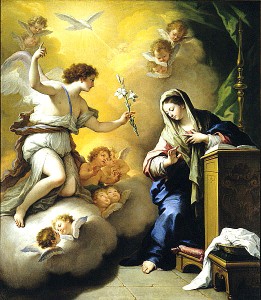 Before you think I’ve gone mad, let me just explain that 25th March, or Lady Day, was the start of the New Year in Tudor times. Lady Day, or the Feast of the Annunciation of the Blessed Virgin, was a feast day commemorating the day that the Virgin Mary was first told by the Angel Gabriel that she was carrying Jesus. It was the first day of the calendar year in England until 1752, when it was changed to 1st January and the Gregorian Calendar replaced the Julian Calendar. Although the year officially started on this day, New Year’s gifts were still given on 1st January, which came from the Roman tradition of New Year.
Before you think I’ve gone mad, let me just explain that 25th March, or Lady Day, was the start of the New Year in Tudor times. Lady Day, or the Feast of the Annunciation of the Blessed Virgin, was a feast day commemorating the day that the Virgin Mary was first told by the Angel Gabriel that she was carrying Jesus. It was the first day of the calendar year in England until 1752, when it was changed to 1st January and the Gregorian Calendar replaced the Julian Calendar. Although the year officially started on this day, New Year’s gifts were still given on 1st January, which came from the Roman tradition of New Year.
Historians and researchers have to bear Lady Day in mind when reading primary sources and reading tomb inscriptions etc. For example, according to primary sources Thomas Boleyn died on 12th March 1538, but to us this is actually 1539. In Thomas’s time, 1539 didn’t start until 25th March and he died before that, but to us 1539 started on 1st January – complicated!
Trivia: The UK tax year starts on 6th April which dates back to 1753 when rents were due on Lady Day (it was a Sunday so the taxes were due on 26th March), the old New Year, but because 11 days were skipped due to the implementation of the new Gregorian Calendar they became due on 6th April.
On Lady Day in 1555, during Mary I’s reign, diarist Henry Machyn recorded jousting at Westminster which was in celebration of the feast day:
“The xxv day of Marche, the wyche was owre lade [day,] ther was as gret justes as youe have sene at the tylt at Vestmynster; the chalyngers was a Spaneard and ser Gorge Haward; and all ther men, and ther horsses trymmyd in whyt, and then cam the Kyng and a gret mene [menée or retinue] all in bluw, and trymmyd with yelow, and ther elmets with gret tuyffes [tufts or plumes] of blue and yelow fether, and all ther veffelers [whifflers or forerunners] and ther fotemen, and ther armorers, and a compene lyke Turkes red [rode] in cremesun saten gownes and capes, and with fachyons [falchions] and gret targets ; and sum in gren, and mony of clyvers colers; and ther was broken ij hondred stayffes and a-boyff [above].”
The only knight named is Sir George Howard, but the knights were both English and Spanish, and a record two hundred staffs were broken.
Notes and Sources
- The Diary of Henry Machyn: Citizen and Merchant-Taylor of London (1550-1563)
- On This Day in Tudor History, Claire Ridgway